
I BLOG HERE
-- June 27, 2025 --
For the True Hardcore Heads
All the original demo and 7" tracks, as well as both LPs, from my old band Timescape Zero have been uploaded to Spotify and all other streaming platforms.

I've been told it's a must for fans of Cro-Mags, Sick Of It All, and Agnostic Front, but don't take my word for it. If you're into 90s metallic hardcore, feel free to check it out.
-- June 13, 2025 --
Mail Call!
I created a free, one-page, mini-zine which collects 14 of my favorite throwaway poems. Contact me if you'd like one (or some).
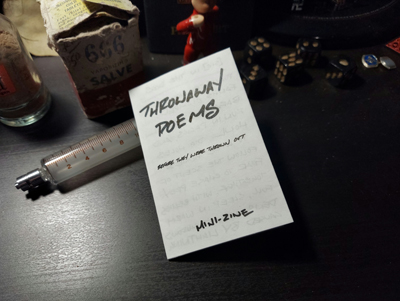
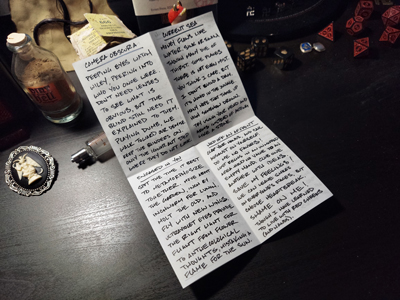
Don't know what my throwaway poems are? Click here to find out.
-- June 06, 2025 --
Don't Throw It In My Face
New art pieces, titled In Case of Riot.
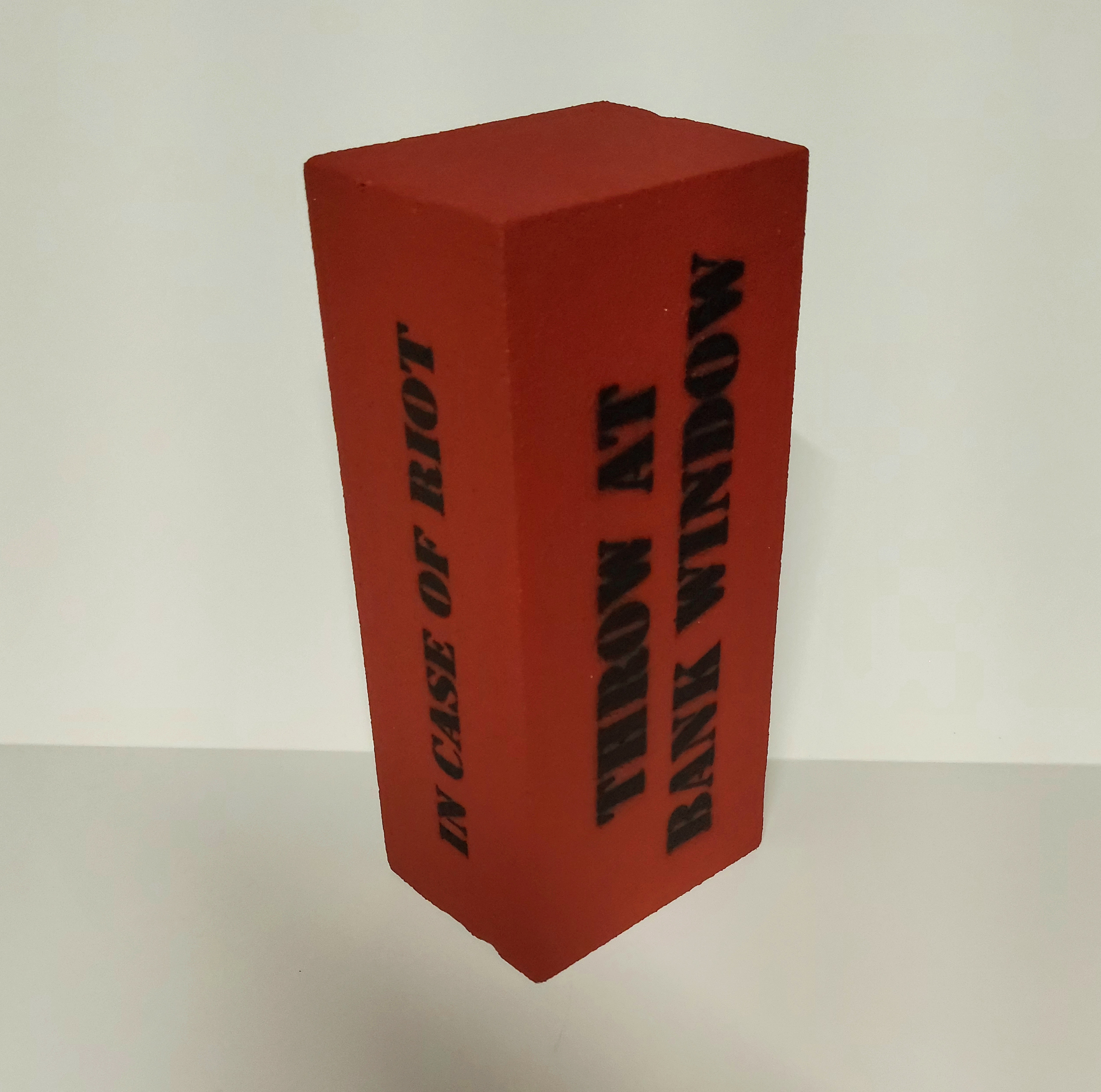
click on image for
larger view
The works are 7.75
by 3.5 by 2.75 inch (20 x 9 x 7 cm) stenciled foam brick. Limited to only 50,
each is hand signed and numbered.
Contact me for more information.
-- May 19, 2025 --
August 12th through the 23rd, photos from my Ars Moriendi series will be part of the Behind the Veil group art show at Pictor Gallery in New York City.

click on image for
larger view
The opening event with talks from artists will be held on Thursday, August 14th, which I plan on attending, so drop on by if you're in the area.
-- December 13, 2024 --
Always on the Road
New photo zine, titled In the Driver's Seat, out now!
This zine contains
42 of my "dashboard photographs", collected to represent the loneliness
of life on the road.
Available at my
Etsy for only $9 (with free shipping in the United States).
-- November 29, 2024 --
A Truly Happy Birthday
Thanks for the
birthday well-wishes! Some good things in store for the upcoming month.
A few of my composite mirrored images from my Blue Earth series will
appear in Issue 2 of the abstract photography magazine Hintology.

Out some time this
month, calling Hintology a "magazine" is an understatement.
More like a book, they are growing exponentially to become the premier outlet
for abstract photography and photographic artists.
Also, one of my Ars Moriendi photographs (Work V, see previous
entry) will appear as the cover for Issue 30 of dark literature fanzine The
Inflated Graveworm, which will be out in February.
-- October 01, 2024 --
Them Dry Bones
I've begun a new B&W photo series, titled Ars Moriendi (meaning "the art of dying"), which -using real human bones and nude models- is meant to serve as a memento mori.
Currently, Works III, V and VIII are available as 8 x 10" (20 x 25.5 cm) and 5 x 7" (13 x 18 cm) signed prints through my Etsy.
-- September 13, 2024 --
Let's Fly
My photo of a Red-Winged Black Bird (Agelaius phoeniceus) attacking me has been included in Coin-Operated Press' Birds issue.
Click on the link
to order, or look for it wherever you get your favorite fanzines.
Also, my photo "The Crowd" will be included in the upcoming issue
of Cinema
Schism, which focuses on the films of underground legend Charles
Pinion.
Lastly, I restocked one of my classic, long-sold-out bumper stickers.
It's now a three-pack,
which includes: two 8.5 x 2.75" (21.5 x 7 cm) END HUMANITY NOW! screen-printed
vinyl bumper stickers, and one 5.5 x 4.25 (14 x 11 cm) I DON'T WANT DEPOPULATION
screen printed vinyl bumper sticker.
If you'd like some, head on over to my
Etsy to order. They're only $2 with postage paid!
-- August 03, 2024 --
Alive and Well
If you're in the
Detroit area, 156 is playing the first live show since 2017 on August 17th (@
7pm).
It'll be at Huckleberry Explorers Club Museum, 2660 Buchanan Street, and will
also feature live performances by Aporrheta Andalusian Cat and John Collins
McCormick.
My offering will be very ritualistic as a public display of memento mori,
which I have yet to do in a live setting.

I will have CDs and cassettes available, as well as two new 156 stickers. If you can't make it, and would like free stickers, email me a mailing address and I'll get some out to you.
-- July 03, 2023 --
Unsolicited Quick Pics
My photograph "Two Halves" has been selected for The Chateau Gallery's online exhibit, Shadow and Light, running all of July.
Though it's a digital
showcase, I'm proud to have been chosen to be one of the artists featured. The
gallery is an illustrious studio, located within historic Old Louisville's Bockee
Manor, yet holds many online exhibits featuring artists from around the world.
Click here
to visit the exhibit.
Also, two of my mirrored composite photographs have been included in the newest
issue (No. 11) of the collage fanzine Perception.
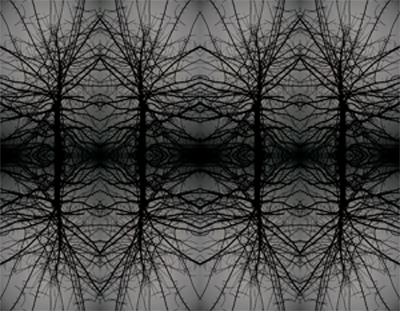
Lastly, one of my photos, titled "Cracked Up", can be seen in the new DissArmoníe fanazine Mirrors/Windows.
-- March 24, 2024 --
Let's Hang Out
For those in the Detroit area this Spring, I'll have a table at this year's Detroit Zine Fest, which will take place at The Jam Handy (2900 E Grand Blvd) on April 6th from 12pm to 6pm.

I will have all of my zines and books, as well as some prints and music available.
-- March 11, 2024 --
Keep Your Chin Up
I've been taking photographs of some of the most interesting ceilings in Detroit. The project (titled Look Up, Even Indoors) will premier as a six-panel set at the Welcome to Detroit! art exhibit.

click on image for
larger view
The show carries 48 artists, and runs from March 14th to May 2nd at the Grosse Pointe Artists Association, opening with a talk from Executive Director of the Detroit Artists Market, Miah Davis.
-- February 09, 2024 --
I Could Go On and On
I have an interview up at The Aither, which was done by Erin Powell of Awen. It covers my musical history, love of fanzines, and playing with human bones.
Check it out!
-- January 16, 2024 --
A Happy New Year Indeed
My photo "The Crowd" will be displayed at the Grosse Pointe Artists Association Gallery (32 Lake Shore Dr) for their show Today's Weather, which opens on January 27th with a talk by National Weather Service meteorologist Kevin Kacan, and will be on display until March 8th. UPDATE: I'm proud to announce that out of 60 artists, my work has won the 3rd Place juried prize.

click on image for
larger view
-- December 15, 2023 --
Rattle Them Bones
Since my Memento Mori 10" is now sold out, I've decided to press all thirteen songs from those sessions on a professionally produced CD-R digipak, and limited edition cassette tape.



Recorded from 2012
to 2015, and using only human bones, it was originally released on bone colored
vinyl in 2016 as a nine-track EP. This CD-R pressing comes in a full-color digipak
which will remain in print, but the cassette is limited to only 50 copies, yet
each contains four extra tracks not on the vinyl, one of which was previously
unreleased. You can check out the music video for the first track ("Kokoro")
here,
as well as track five ("Me-Olam, Ad-Olam") here.
The disc and tape are a mere $10 (complete with postage paid in the U.S.), and
are available from the 156
Bandcamp. For an additional $5, you'll get four different 156 stickers,
and a chip of human skull!
-- November 29, 2023 --
Listen Up!
Seeing as my Know-It-All Asshole Jerk fanzine is now out of print, I wanted to keep one zine always fully available, so I've decided to repress the long sold-out Musica Obscura, as a new edition, titled Enigmatic Audio.
It collects over
15 different in depth articles on bizarre and rare music from around the world.
Topics include the hatred against the early punk scene, the co-optation of underground
ideas, postmodernist thought in contemporary music, plus brief histories to
the Luk Thung music of Thailand, Cambodia's 60s scene, the transgendered
in music, and sex records.
Unlike Musica Obscura, this fanzine will not come with a free disc of
130+ mp3s, but with a downloadable ZIP file containing every song, so you can
still listen as you read. Also unlike the previous music zine, which was limited
to only 100 copies, this one will remain in print as long as possible.
Enigmatic Audio is now available for $10 with postage paid in the U.S.
Make contact for copies, or hit
up my Etsy.
-- October 13, 2023 --
Not An Unlucky Friday, I'd Say
I've wrapped up the Know-It-All Asshole Jerk book, Encyclopedia Obscurum. If you're a fan of my blog, but are tired of reading it all online, then you'll definitely dig it. Over 260 pages, with around 300 entries of bizarre true stories covering art, music, literature, hoaxes, religion, lifestyles, and random weirdoes. With a cover designed by Iron Forge Press' Chuck Loose!
The book is $25
with postage paid. You can contact
me directly, or visit my Etsy
shop to order.
Not only that, but I recently had a wonderful conversation with Peter Tanski
for The Book of Very Very Bad Things podcast: Book II, Chapter MIV (Episode
106). We not only covered my musical, and artistic history, but had a deep dive
into politics, philosophy, religion, mysticism, as well as the health of our
bodies and minds.
Listen in on our talk wherever you tune into podcasts.
-- September 23, 2023 --
Everything's Coming To A Grinding Halt
The Cure sang it,
and I'm doing it. It's been my goal to keep this blog going for as long as I
could, but then I decided to stop when the Know-It-All Asshole Jerk book, Encyclopedia
Obscurum, comes out. With a release date of October 1st, I guess this is
the last entry here where I'll cover a strange topic (beside my releases, and
personal updates). What better way to close it out than write about how the
end can be kind of delicious.
According to The Washington Post, between March 2020 and October 2021,
430 obituaries referencing casseroles were published in American newspapers
and online obituary platforms. It seems that, even after death, many of us still
want to share good food. This could be why "gravestone recipes" exist.
University of Maryland
grad student, and social media influencer, Rosie Grant has been collecting,
and baking, as many of these recipies as she can find since the pandemic lock
down. Most of the recipes have been for desserts, among them are Naomi Miller-Dawson's
Spritz cookies (seen here), Kathryn Andrews' Fudge, the Connie family's date
and nut bread, and Margaret Davis' glazed blueberry pie, though last year she
discovered her first non-dessert recipe for red lantern cheese dip. The trend
to collect these cemetery delicacies is picking up, as the website Atlas
Obscura is now cataloging them online, and publishers Allison C. Meier,
Bronwyn Hazelwood, and Claire Voon have put together the fanzine Cooking
with the Dead: A Zine of Tombstone Recipes.
As yummy as that is, I'm not going to bullshit, and say I'm glad this is all
over. It's been great fun sharing with my readers some of life's strangest subjects
for the last eleven years, but everything comes to an end. I hope many of you
visit back often to check in on what new art, music, and publishing projects
I'm involved in. Keep it weirtd, folks!
-- September 10, 2023 --
ZERO!
In 2021, Damien
Moyal of As Friends Rust began a new publishing project titled LORE:
A Zine About Demos. Each release is a boxset that included a fanzine,
a repress of the cassette demo he's covering, along with extra goodies. Issue
1 was for the band Trauma, and their Eve of the Mindblast demo from 1992.
It contained a 44-page retrospective booklet of interviews, flyers, photos and
artwork, a remastered reissue of the original demo tape, a pack of button pins,
a woven patch - all packaged in a custom-printed box.
I'm proud to announce that Issue 2 covers my old band Timescape Zero, and our
1991 demo Welcome to the Kali Yuga.
This new issue
includes a 30+ page half-size fanzine, along with the remastered cassette (completely
reproduced like the original), plus an embroidered patch, and a balaclava. Of
course, it comes in an amazingly beautiful box, made especially for display.
As with Issue 1, you can purchase the boxset, which is limited to 50 copies,
or the zine alone, which is limited to 100 copies (50 in the boxset, 50 stand-alones).
Check out the LORE
Bandcamp for ordering info!
-- September 04, 2023 --
Holy Moldy!
I've written of some strange holy relics before -from several religions- but Christianity has some of the weirdest. Sure there's the Shroud of Turin, and I posted of the Status Quo (known as the Immovable Ladder), but some lesser known ones include the Sudarium of Oviedo (a bloodstained cloth said to have once been wrapped around the head of Jesus Christ after he died), and supposed pieces of the "True Cross" claimed to be remnants of the cross Jesus was crucified on, preserved in hundreds of European churches. Still, the oddest of all has to be The Holy Prepuce.
The Holy Prepuce,
or Holy Foreskin (Latin præputium or prepucium), is one of several
relics attributed to Jesus Christ, and is said to be a product of his circumcision.
At various times throughout history, various churches in Europe have claimed
to possess it, sometimes at the same time. These foreskin relics began appearing
in Europe during the Middle Ages, with the earliest on record being December
25, 800, when Charlemagne gave it to Pope Leo III upon him being crowned Emperor.
Charlemagne claimed it was given to him by an angel as he was praying at the
Holy Sepulchre in Jerusalem. Its authenticity was later "confirmed"
by Saint Bridget of Sweden, after having a vision. Another, and one of the most
famous, arrived in Antwerp in 1100, as a gift from King Baldwin I of Jerusalem,
who purchased it during the First Crusade. This piece of foreskin became famous
when the Bishop of Cambray saw three drops of blood dropping onto the linens
of the altar during a mass. A chapel was constructed to house it, which became
the goal of many pilgrimages. While most of the prepuces were lost or destroyed,
the Italian village of Calcata paraded a reliquary containing the supposed holy
foreskin through its streets as recently as 1983 during the Feast of the Circumcision.
According to a source from the 19th Century, the Vatican librarian Leo Allatius
wrote an unpublished treatise in the late 17th Century, titled De Praeputio
Domini Nostri Jesu Christi Diatriba (A Discussion of the Foreskin of
Our Lord Jesus Christ), claiming that -like Jesus himself- the Holy Prepuce
ascended, and was transformed into the rings of Saturn. Since then, it has been
mentioned in Voltaire's A Treatise of Toleration (1763), James Joyce
in his 1922 novel Ulysses, Umberto Eco's Baudolino (2000), and
in 2001's Choke by Chuck Palahniuk.
As I mentioned before, Christianity has no single claim to strange relics. It
just seems they have the market cornered on some of the strangest.
-- August 23, 2023 --
Art Attack
I've written about
art vandalism here before, and it seems like it's gotten out of control lately,
but that's only because of two things. First, the 24-hour news cycle has us
hearing about it a lot more now. Many cases of art vandalism throughout the
late-20th Century went under- or unreported. Second, many of what has been reported
the last few years are protests where climate change activists are throwing
oil or gluing themselves to famous artworks. As much as I disagree with their
methods, they are doing this to works that are heavily protected, and no damage
is caused, but a story on the event will certainly be carried by some news organization.
Still there are some forms of art vandalism that boggles the mind. Take the
case of the destruction of a work by Roy Lichtenstein.
In 1993, the St.
Louis Art Museum loaned New York City's Whitney Museum of American Art a large
1962 Roy Lichtenstein canvas painting, titled "Curtains". At that
time, it was valued at $1.5 million to $2 million. Within days of the organization
displaying it, 21-year-old Brooklyn security guard, Reginald Walker, used a
felt-tip marker to write ''I love you Tushee, Love, Buns'' along with a heart,
further inscribing ''Reggie + Crystal 1/26/91'' on the work. Why he wrote a
year as two years before makes it all the stranger. Anyhow, in 1996, the St.
Louis Art Museum filed a $2.5 million Federal lawsuit against the Whitney Museum,
and its security services, R.S.R. Security Services of Long Island City. I have
tried looking up what happened to the guard, and to see if he ever gave an excuse
as to how he could do something so stupid, but haven't been lucky enough to
get more info than I'm presenting here.
I guess it doesn't matter why, as any excuse is a dumb excuse. In 1912, a young
woman kissed the face of a portrait by François Boucher in the Louvre
several times. When asked why, she claimed to just want to draw attention to
herself. In
1977, 43-year-old Ruth van Herpen kissed a painting by Jo Baer at the Oxford
Museum of Modern Art, stating she wanted to "cheer up" a "cold"
painting. Officials didn't care for her input, and she was forced to pay restoration
costs ($1,260, or $6,355 today). In 1988, and 2007, two other women kissed paintings,
one of which by Andy Warhol was unvarnished, and therefore ruined. These lipstick-related
incidents of art vandalism has actually led a number of museums to require female
guests to remove makeup before entering.
No matter the reason, cause, or desire... leave art out of it. Punch, or kiss,
a politician. That might actually help society somewhat.
-- August 14, 2023 --
I Dig This
Every so often,
researchers in the field of archeology present us with new information that
rewrites our timeline as a species. This year alone, new discoveries have pushed
back the date for the earliest artwork, and the peopling of the Americas, as
well as producing some oddities that we can't yet explain. With that written,
let's check out some of them...
A team of Chinese researchers are currently analyzing cave art that -if correct-
is now thought to be the world's oldest art.
Estimated to be
between 169,000 and 226,000 years old, the work was found in a hot spring at
Quesang, a village located on the Tibetan Plateau, at an altitude of 2,652 ft
(4,269 m) above sea level. Originally discovered by a local resident in the
1980s, the site had not been excavated until 2020. The artwork consists of four
right footprints, a "superimposed" left footprint, and five handprints.
On average, the footprints are about 7.5 inches (19.22 cm) long, and comparing
the shape and size of the imprints to that of both modern and prehistoric footprints,
the researchers determined that they belonged to a child (around eight years
old). Two of the footprints were shaped differently than the rest; the researchers
proposed that the child must have curled their toes while walking. Despite their
frequent use of the term "impressions", the researchers admitted they
are not certain whether the shapes were pressed onto soft clay, or carved into
solid rock. With the consistency of the shapes, not and the varying pressures
that must have been applied, ichnologists favor the first hypothesis. Admittedly,
although the unnatural arrangement of the Tibetan imprints strongly suggests
they were created intentionally, it's debatable whether they represent art.
According
to a study published this month in the Biological Sciences section of The Royal
Society's Proceedings B, a team of thirteen researchers have discovered
evidence of successive human settlements in central Brazil's Santa Elina rock
shelter dating back to the Last Glacial Maxim (~20,000 years ago).
Two Pleistocene
archaeological layers included rich industry associated with the remains of
the extinct giant ground sloth, Glossotherium phoenesis. The remains included
thousands of osteoderms (dermal bones), three of which were human-modified.
In this study, they performed traceological analysis of the artifacts by optical
microscopy, nondestructive scanning electron microscopy, UV/visible photoluminescence,
and synchrotron-based microtomography. In the paper, the scientists described
the spatial association between the giant sloth bone remains, and stone tools,
provided a Bayesian age model that confirmed the timing of the association.
Their conclusion from the traceological study is that the sloth osteoderms were
intentionally modified into artifacts before fossilization of the bones, which
provided additional evidence for the contemporaneity of humans and sloths, as
well as for the human manufacturing of personal artifacts on bone remains of
those sloths, around the time period of the Last Glacial Maxim in central Brazil.
More research is being conducted, as the timeline of the peopling of the Americas
this far south remains hotly debated.
In 2016, an international team of archaeologists, ethnographers, and historians
working at a dig site in the Khangai Mountains of northern Mongolia uncovered
a stone about 1.5" (4 cm) in length, which had been carved by human hands.
The research team
recently took a closer look at the stone, which was originally named simply
T21, and dated it to approximately 42,400 to 41,900 years ago, in the Upper
Paleolithic. They suspect the grooves were carved into the stone to make it
resemble a human penis, further suggesting the midsection groove was meant to
represent the glans, while the top-to-bottom groove was meant to replicate the
urethral opening. The conclusions drawn by the team have resulted in comments
by others in the field, with many noting that the stone could just be a tool
used for an unknown purpose, but if the researchers are correct, this find is
the oldest known representation of a penis. The current oldest is roughly half
that age - a stone that was carved approximately 28,000 years ago, and found
in Germany, called the Hohle Fels Cave phallus.
A new study
published in Scientific Reports, National Museum of Natural History paleoanthropologist
Briana Pobiner and her co-authors describe nine cut marks on a fossilized 1.45
million-year-old left tibia (shin bone) from a relative of Homo sapiens
(either an Australopithecus boisei, or Homo erectus) found in
northern Kenya.
The analysis positively
identified nine of the 11 marks as clear matches for the type of damage inflicted
by stone tools. The other two marks were likely bite marks from a big cat, possibly
one of the three different types of saber-tooth cats in the area of that time.
None of the stone-tool cut marks overlap with the two bite marks, which makes
it hard to infer anything about the order of events that took place, but the
cut marks are thought to be from the oldest known instance of hominid cannibalism.
By themselves, the cut marks do not prove that the human relative who inflicted
them also ate the victim, but Pobiner believes this to be the most likely scenario.
Paleoanthropologist and National Geographic Explorer in Residence Dr. Lee Berger
and his team of researchers have recently discovered the remains of adult and
children Homo naledi (a cousin to Homo sapiens) that were laid
to rest in the fetal position within cave depressions, and covered with soil
within the Dinaledi Chamber of the Rising Star Cave in South Africa.
These burials are
older than any known human burials by at least 100,000 years. The scientists
also found a number of symbols (hashtag-like cross-hatchings and other geometric
shapes) engraved on the cave walls, which are estimated to be between 241,000
and 335,000 years old. However, they want to continue their testing for more
precise dating, as -if these dates are correct- they would be the oldest known
symbols / art created by any humanoid species.
A team led
by senior archaeologist Letty Ingrey of the UCL Institute of Archaeology has
discovered a total of 800 artifacts, thought to be more than 300,000 years old,
and buried in material that filled a sinkhole and ancient river channel on a
hillside above the Medway Valley, near Kent.
This includes a
foot-long hand axe almost too big to be handled, of which Ingrey said, "These
hand axes are so big it's difficult to imagine how they could have been easily
held and used," and speculated that the tools might have fulfilled a less
practical or more symbolic function. Adding, "Right now, we aren't sure
why such large tools were being made, or which species of early human were making
them. This site offers a chance to answer these exciting questions." The
excavation site is thought to date to a period in the early prehistory of Britain
when Neanderthal people were beginning to emerge, possibly having shared the
landscape with other early humanoid species.
Admittedly, as a kid I wanted to become an archeologist, but never followed
that dream, so all of this is extremely fascinating to me. Still, I hope a few
of you find this just as interesting, and if I can convince someone to go into
a field of study in this area, all the better. I mean, there are worse things
than finding yourself prospecting through dirt.
-- August 01, 2023 --
The Mind Is A Terrible Thing to Tease
This one's going to be a bit of a long entry, as I'm going to cover a few of the phenomena that goes on in the wonderful space between our ears. We've all experienced a few of these, but doubtful all of them, so let's take a trip deep within, and see what our beautiful brains are capable of.
First up is the Kiki-Bouba Effect; a non-arbitrary mental association between certain speech/sounds to certain visual shapes. This effect was first observed by Georgian psychologist Dimitri Uznadze in a 1924 paper, and later expanded upon in experiments by German American psychologist Wolfgang Köhler in 1929. The effect got its name from a 2001 experiment by neuroscientists V. S. Ramachandran and Edward Hubbard, where they repeated Köhler's experiment using the words "kiki" and "bouba". The duo asked American college undergraduates, and Tamil speakers in India, "Which of these shapes is bouba and which is kiki?" In both groups, 95% to 98% selected the curvy shape as "bouba" and the jagged shape as "kiki". The results suggest that the human brain somehow attaches abstract meanings to the shapes and sounds consistently. After further studies, it is thought that there is a worldwide general tendency towards the effect, as it was robustly confirmed across a majority of cultures and languages. The effect was investigated using fMRI in 2018 by Nathan Peiffer-Smadja and Laurent Cohen (and again by Kelly McCormick), who found that prefrontal activation is stronger to mismatching than to matching stimuli, with the most activity in parietal regions including the intraparietal sulcus and supramarginal gyrus, which are known to play a role in sensory association and perceptual-motor processing. Many who write on the subject, including Ramachandran and Hubbard, state that the Kiki-Bouba Effect has implications for the evolution of language, as it suggests the naming of objects is not totally arbitrary.
The legend of Bloody Mary is about a malevolent spirit said to appear in a mirror when her name is chanted repeatedly. It is now believed that the folklore surrounding her stems from the Strange Face Illusion, first described by the psychologist Giovanni Caputo of the University of Urbino, Italy. Urbino’s original study, published in 2010, reported illusions experienced by people looking at themselves in the mirror in low light conditions. According to an article in 'Scientific American Mind' on the subject, "Caputo asked 50 subjects to gaze at their reflected faces in a mirror for a 10-minute session. After less than a minute, most observers began to perceive the “strange-face illusion.” The participants’ descriptions included huge deformations of their own faces; seeing the faces of alive or deceased parents; archetypal faces such as an old woman, child or the portrait of an ancestor; animal faces such as a cat, pig or lion; and even fantastical and monstrous beings. All 50 participants reported feelings of "otherness" when confronted with a face that seemed suddenly unfamiliar. Some felt powerful emotions." In a subsequent experiment, Caputo observed that this phenomenon was not limited to one's face reflected in the mirror, but extended to other people's faces, in situations where pairs of participants gazed at each other for sustained periods of time in a dimly lit room.
The image on the
left contains two perfect circles, but it's hard to tell, due to the Intertwining
Illusion, caused by your visual system receiving conflicting cues. Parts of
your brain view circles, and others view a spiral. In the periphery of vision,
the spiral cues win.
The image on the right has sixteen circles in it, but they're also hard to see.
This is called a Coffer Illusion, or Coffer Ambiguous Figure, created in 2006,
by San Francisco-based vision scientist Anthony Norcia of the Smith-Kettlewell
Eye Research Institute, this optical illusion has 16 circles hidden within.
This illusion is where a two-dimensional figure, or three-dimensional object,
can be seen in two or more sharply distinct ways, often hiding ambiguous figures
(also known as "reversible figures" or "bistable figures").
There is some controversy over how the Coffer Ambiguous Figure works, but generally
agreed that the retinal image is constant when experiencing the illusion. What
is not agreed is whether the visual experience of the figure changes when the
prospective switch takes place between seeing the hidden figures, versus not
seeing them, or whether the experience itself does not change, and it is some
post-experiential belief, judgment, or other mental process which changes.
All three spheres in this image are the same color: a dull pink. This is a three-color confetti illusion using the Munker-White Effect, caused by the brain organizing color information based on luminance.
If you stare at the image above long enough, the colors will completely disappear. This is known as Troxler's fading, or the Troxler effect, first identified by Swiss physician Ignaz Paul Vital Troxler in 1804. It's an optical illusion affecting visual perception when one fixates on a particular point, and an unchanging stimulus away from the fixation point will fade away and disappear. Troxler's fading is mainly attributed to the adaptation of neurons vital for perceiving stimuli in the visual system, and is part of the general principle in sensory systems where unvarying stimuli disappear from our awareness.
Lastly, stare at
the image above for fifteen seconds, then look at any white space on this screen.
This effect is called the Negative Optical Illusion (or Negative Picture Illusion),
which works on the Opponent-Process Theory of color vision. It happens because
when you stare at one negative image for a long time, the cone cells that are
sensitive to the three main colors (red, green, and blue) become fatigued. The
receptors adapted to specific colors will respond by sending a weak signal.
Then, when focusing on a white surface, surrounding color receptors send out
a strong signal to the brain. As those signals are received from the three color
receptors, they're not in balance, and our brain processes afterimages as colored
pictures.
This is by no means all of the interesting illusions that affect us, though
covering every one of them could make an interesting blog unto itself. Still,
I hope I shed a little light on the fact that -while seeing is believing- seeing
itself can sometimes be misleading.
-- July 23, 2023 --
Let's Ride
The Forgotten Rides photo book is due out October 1st. I made postcard prints to go along with this release.

click on image for
larger view
The four postcard
print set from the Forgotten Rides photo series are glossy, full color,
5 x 7" (13 x 18 cm) prints on heavy cardstock, limited to 200 hand-numbered
copies, and presented in an envelope with an embossed silver seal.
They are available for $10, with postage paid within the United States, and
are available through my
Etsy.
-- July 13, 2023 --
Oh, Japan
I'm sure by now
most of you are familiar with the infamous 2002 - 2007 British tv show, Japanorama.
Produced by the BBC, and hosted by comedian Jonathan Ross, it was three seasons
(18 episodes) of unusual Japanese films, shows, anime, manga, and culture. However,
one thing they didn't cover a lot of was weird history. Here are two quick oddities
from the world of Japanese literature, and art.
First, there's the Japanese book titled Osanaetoki Bankokubanashi, from
1861, that is an illustrated history of the United States. Yet, the stories
and accompanying illustrations are extremely fanciful, and totally fictional.
There is the story of George Washington fighting a tiger, John Adams battling
a giant snake (which ate his mother), and Washington defending his wife "Carol"
from a British official named "Asura", and his goons.
There are other
crazy stories, such as Benjamin Franklin firing a cannon held with his bare
hands, and John Adams meeting a mountain god, who summons an eagle to kill the
previously mentioned snake. The book was authored by Kanagaki Robun, and was
written completely from second hand information. The illustrations were done
by artist Utagawa Yoshitora, and -if you're interested in seeing the book in
its entirety- it is freely available online courtesy of the Waseda University
Library (click
here to view).
The other bit of Japanese weirdness for this post concerns He-Gassen
(which translates to "fart competitions").
They are scenes
in Japanese art created during the Edo period (1603 - 1868), mostly by unknown
artists depicting flatulence humor. Notable examples include the Kachie Emaki
scroll, an anonymous 15th Century copy of an earlier work, now in the Mitsui
Memorial Museum; the Houhe Gassen Emaki scroll, a 1449 copy of earlier work
by an unknown artist, now in the Suntory Museum of Art; the Houhe Gassen Zu
sliding screen, which has an unknown date, as well as artist, and it is now
in the Kochi Museum of Art; the Houhe Gassen Emaki double scroll by Kawanabe
Kyosai, who created it in 1867, and can be seen at the Kawanabe Kyosai Memorial
Museum in Warabi, Saitama; lastly is the more modern Onara Gassen by Ogawa Usen,
which was done in 1921, currently showing at the Fukushima Prefectural Museum
of Art.
None of this is to say that the Japanese have a claim on the bizarre, nor are
Westerners free from the pointing fingers of derisive laughter. As they say,
"What is normal, anyway?" All cultures have some things that seem
strange to outsiders, but if you can't have a chuckle at the peculiar, you may
be lacking a sense of humor. It's okay to point out (and enjoy) the outlandishness.
Just don't be a dick about it.
-- July 01, 2023 --
Keep Rollin'
The Forgotten Rides photo book will finally be out later this year. It'll have 180+ full-color, 9" x 7" (23 x 18 cm) photos, and will be a hand-numbered softcover, limited to 200 copies.

However, while the proof copy of the Forgotten Rides photo book is on its way to me, and the projected release date is now October 1st, I have produced a new related fanzine, Forgotten Rides: The Fanzine, Wheel Edition.
It's a full-color, glossy, landscape 5.5" x 8.5" (14 x 21 cm) zine, limited to only 50 copies, containing 22 photos not found in the upcoming book. All copies are hand signed / numbered, and available for only $8 postage paid from my Etsy shop (add another $5 outside the United States).
-- June 21, 2023 --
Knee Slappers Delight
In case you're
new here: I LOVE PRANKS! They're not all great, but most of them are pretty
fun in some way, or another. I've recently come across a few that were new to
me, and I thought I'd share, so here we go.
In 1969, Capitol Records wanted to promote the Beatles' "Abbey Road"
album in Los Angeles with a billboard above the Sunset Strip. They transformed
John Kosh’s album cover, with the help of designer Roland Young, by -just
like the LP- keeping the image free of text. They kept most of the original
album design, but cropped out the London street, and extended the heads outside
the parameters of the rectangular billboard to make it look as if the band was
crossing Sunset Blvd. Within days, Paul McCartney was decapitated, and his head
was stolen. The billboard company then called Young, who was working in the
nearby Capitol Records building. Young’s initial instinct was to replace
it, but when he drove to the site, he changed his mind. At that time, rumors
were spreading that McCartney was killed in a car accident in 1966. Conspiracy
theorists interpreted the "Abbey Road" album cover as a funeral procession
with John as the clergyman in all white; Ringo being a mourner dressed in black;
George, wearing jeans, was a gravedigger; and Paul’s bare feet symbolized
his death because the dead are buried without shoes in certain burial practices.
Young believed the missing head would garner more attention than the original
design. Anyhow, what happened remained a mystery until 2012, when a man named
Robert Quinn confessed that he stole it as a prank on his 19th birthday, and
McCartney’s head was not only still in his possession, but prominently
displayed in his living room. Not sure if he ever knew how he may have helped
record sales in his area.
The Chicago Tribune, The Scranton Republican, The Rochester, New York Democrat and Chronicle, The Salt Lake Herald-Republican, and The Lincoln Star newspapers all ran the same story on Sunday, April 1, 1906. The two-page piece showcased in this photo (and seven others), along with a story about the invasion of Chicago by "hordes of prehistoric monsters dealing death and destruction".
It described the
events of the invasion, beginning with panicked reports of lake monsters, and
giant bat-like reptiles being sighted in Canada. It then stated that thousands
of dinosaurs, and other prehistoric creatures had arrived in Chicago, with the
initial wave being a swarm of pterodactyls which caused havoc in the Stockyards
District, followed by a horde of seemingly docile, but dangerously large and
clumsy sauropods. It concluded with a rampaging brontosaur, a battle between
a tyrannosaur and a brontosaur on the Montgomery Ward Building tower, and speculation
that the dinosaurs may have been released from Atlantis by some catastrophe,
and were making their way southward as they searched for food and warmth. Very
few took the story as fact, especially after realizing the newspapers were printed
on April Fool's Day.
This next one isn't about a single prank, but the damage done, as well as bizarre
science, some of the more cruel ones can lead to. Baylor University Medical
Center doctors Courtney E. Sutherland, MD, along with corresponding author Toban
Dvoretzky, BA, and Nicholas J. Solomos, MD, held a study on wedgies, producing
the medical paper: Wedgie-Associated Radiculitis in a Quinquagenarian.
Their case study began in 2009, when a 50-year-old man went to the hospital
after a week of lower back pain, as well as numbness and tingling down his left
leg and toes, after his 34-year-old wife gave him wedgie of moderate force as
he was getting up from their sofa. The paper discusses the history of the wedgie,
terms for it (such as the Spanish "calzoncillo chino", meaning "Chinese
underwear"), different types of wedgies (like the "atomic wedgie"),
as well as other case studies of injuries (including that of a 10-year-old English
boy who needed surgery in 2004 to reattach his testicle to the scrotal lining).
The paper ends with a warning "that wedgies can be physically deleterious
and that the outcome of exchanging them is not always benign or purely of sensation-seeking
value."
Well, alright then. I'll just end it on that note, and please know I'm not yanking
your chain here (nor your underwear).
-- June 13, 2023 --
Upcoming Art Show
I'm happy to announce that a work from my Ad Removal As Modern Art series, "ARAMA No. 003" has been selected for the Scarab Club Gallery's 52nd Annual Contemporary Photography group show in Detroit, which will exhibit from June 28 - July 29, 2023.
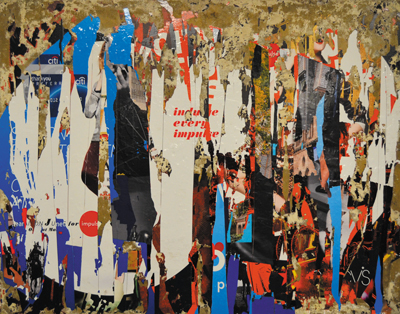
If you would like this project's related photo art book (which is limited to 200 copies), or postcard set (limited to 100 copies), very few copies are available of each, and available at my Etsy shop.
-- June 06, 2023 --
Infinite Jesters
Back when the COVID-19 vaccines have come out, and still a bit today, we've heard a lot of garbage from vaccine deniers - better known as anti-vaxxers. Their general disdain for the vaccines stem from a distrust of either the government, or pharmaceutical companies; claims of a New World Order plot to lower the population; to their belief that COVID doesn't even exist. I'm not here to say any of these idiots are right, but to show that these numbskulls are nothing new. When the first polio vaccine was released in 1954, it received almost 100% approval by the American public, but there were a number of skeptics. In 1967, the mumps was considered too "mild" of a disease by many doctors to necessitate inoculation. Then there were those who thought AIDS wasn't as real as health officials claimed, and nothing was needed to be done about it. Take the case of Christine Joy Maggiore.
Maggiore found
out she was HIV positive in 1992, during a routine medical exam. She soon became
involved in volunteer work for a number of AIDS charities, including AIDS Project
Los Angeles, and Women at Risk. However, after meeting with prominent AIDS denialist
Peter Duesberg in 1994, Maggiore began to question whether HIV causes AIDS,
or if she even had HIV, claiming that her positive test may have been due to
a flu vaccine. In 1995, she founded the group Alive & Well AIDS Alternatives,
which is a 501(c) nonprofit organization of AIDS denialists, who espouses the
viewpoints that HIV tests are inaccurate; pregnant women should not take medication
to prevent HIV transmission to their children; AIDS actually results from malnutrition,
stress, drug use, or other causes; AIDS was not as serious of an issue in Africa
as the media made it out to be; and that mainstream science efforts to promote
AIDS awareness, and develop treatments are examples of fearmongering tied to
the pharmaceutical industry. In 1996, she published the book What If Everything
You Knew About AIDS Was Wrong?, which is still available today. On December
3, 2001, she gave birth to her daughter, Eliza Jane Scovill. Christine chose
not to take antiretroviral medication, which might reduce the risk of transmission
of HIV during pregnancy, and her child acquired HIV. On May 16, 2005, Eliza
Jane collapsed, and was later pronounced dead. An autopsy revealed that Eliza
had died of pneumonia (the leading cause of pediatric AIDS deaths). Even after
her child's death, Maggiore held fast to her views on HIV/AIDS, and -though
attacked by the media- received support from others in the AIDS-denialist community.
She, and her husband, Robin Scovill, later sued Los Angeles County for allegedly
violating their daughter's privacy by releasing her autopsy report. On December
27, 2008, Maggiore died, while under a doctor's care for pneumonia. Her death
certificate states that the cause of death was "disseminated herpes virus
infection and bilateral pneumonia, with oral candidiasis" related to HIV
infection. Fellow AIDS denialists argued that her pneumonia was not AIDS-related,
and that she died of toxic alternative medicine.
You see, no matter when, or even where, there will always be a group of people
who will deny advances in science. Whether they use outdated beliefs, misinformation,
or plain old conspiracy theories, a fool that thinks they're educated is a bigger
fool than the one who knows they are ignorant. So, don't suffer them lightly.
-- May 28, 2023 --
Listen Up!
Taking a quick break from "taking a break from blogging" to let you all know I did an interview with Lydia Lunch and Tim Dahl for Episode 202 of The Lydian Spin podcast. We covered a lot of cool topics, such as truckin', my Memento Mori EP (where all the music was made using only human bones), plus my book on NYC's odd sites and sights, This Hidden City. I had a great time, so tune in at your favorite place to listen to podcasts.
I return to blogging on June 6th with an all new post covering... well, check back then.
-- April 30, 2023 --
Spring Break!
I'm taking a little
break from blogging here, as I'm working hard on the new book, Encyclopedia
Obscurum.
However, you can always take a daily does of Know-It-All Asshole Jerk
over at my Instagram. @knowitallaholejerk
- see you there until I come back!
-- April 09, 2023 --
I'm Blushing
The newest episode of iHeartRadio's Rust Needle's Record Club podcast (where they analyze a new record every week) takes a deep dive into my Memento Mori release -where all the music was played using only human bones- and I'm honored to be covered. While they said some great things about my musical work, they also had a few nice things to say about my art, and poetry.
Listen wherever
you get your podcasts; iTunes, Stitcher, Spotify, Audible, or magic portal.
If you're interested in a vinyl copy of Memento Mori (the 10" is
limited to only 489 copies, and released on bone-colored wax) there are less
than ten copies available at the 156
Bandcamp.
-- April 02, 2023 --
This Is No Joke
No April Fool's Day post this year, but there is a previously unreleased 156 track "De Nugis Curialium" on the new C14H10CO2NNaO2 compilation.
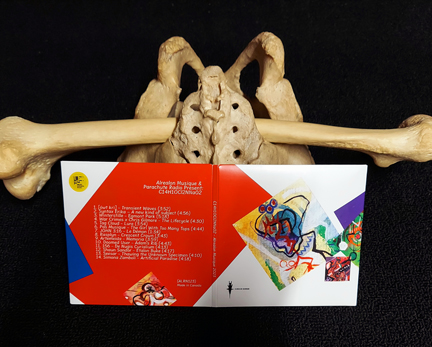
click on image
for larger view
The LP comp, featuring 14 artists from around the world, has been released as 20 cassette copies by French label Parachute Radio, and 150 CDs by U.S. outfit Alrealon Musique.
This
page only holds items from the last year, or so.
Want to read more? For older material, click here.
I
also used to run the photo blogs:
Ad Removal
As Modern Art
Doorway Galleries
This Hidden City
Forgotten Rides
Oh,
yeah! There is also:
My YouTube
My SoundCloud
My Vimeo